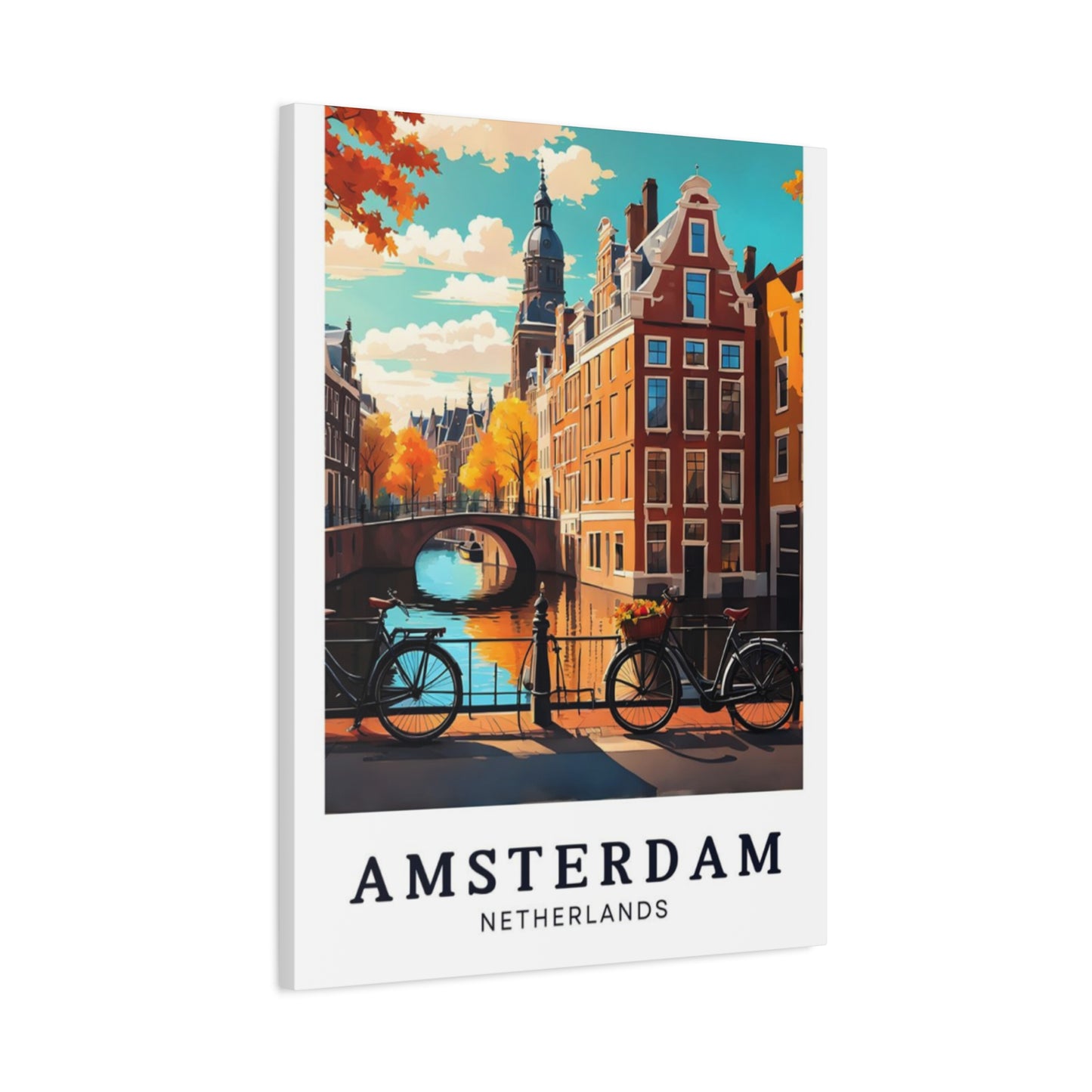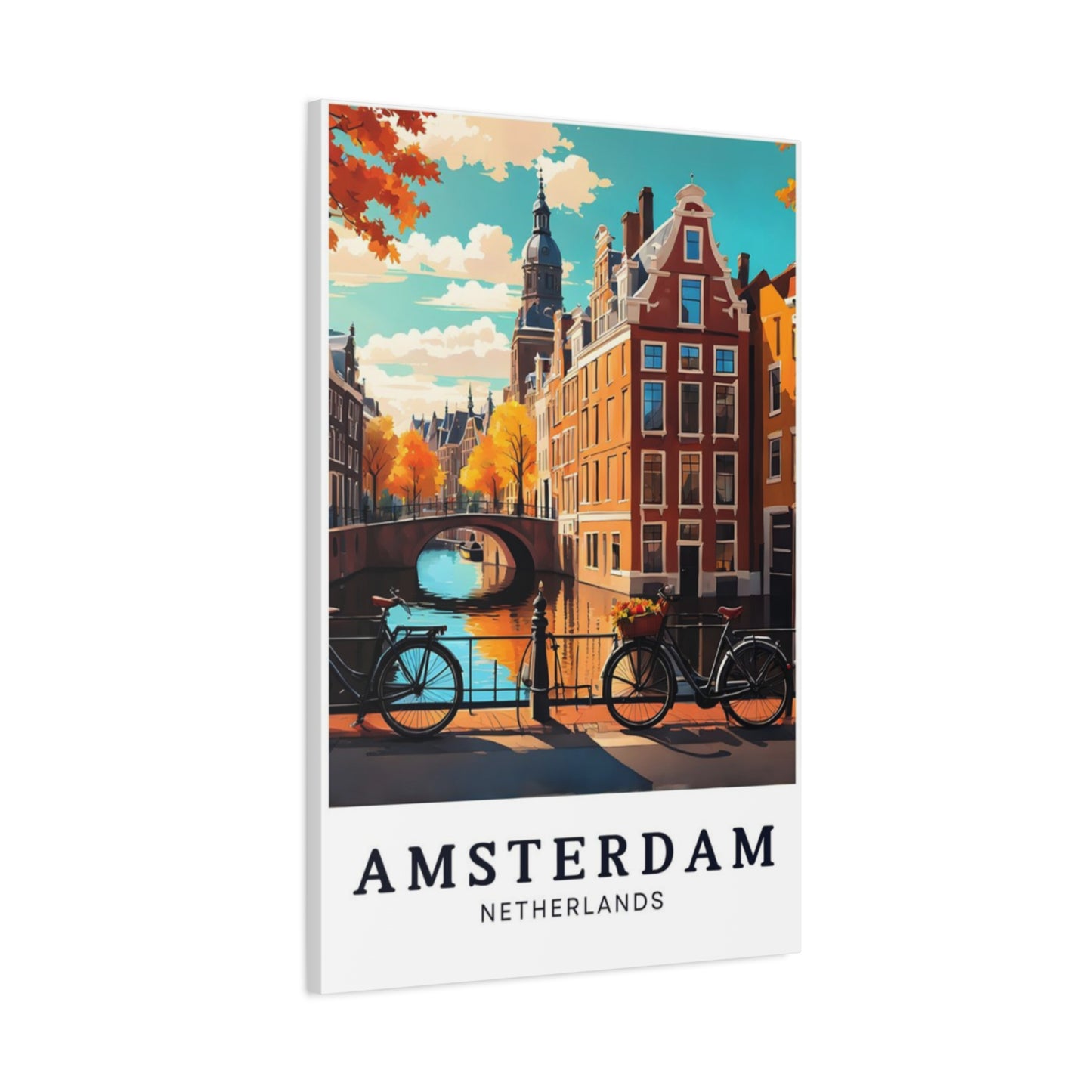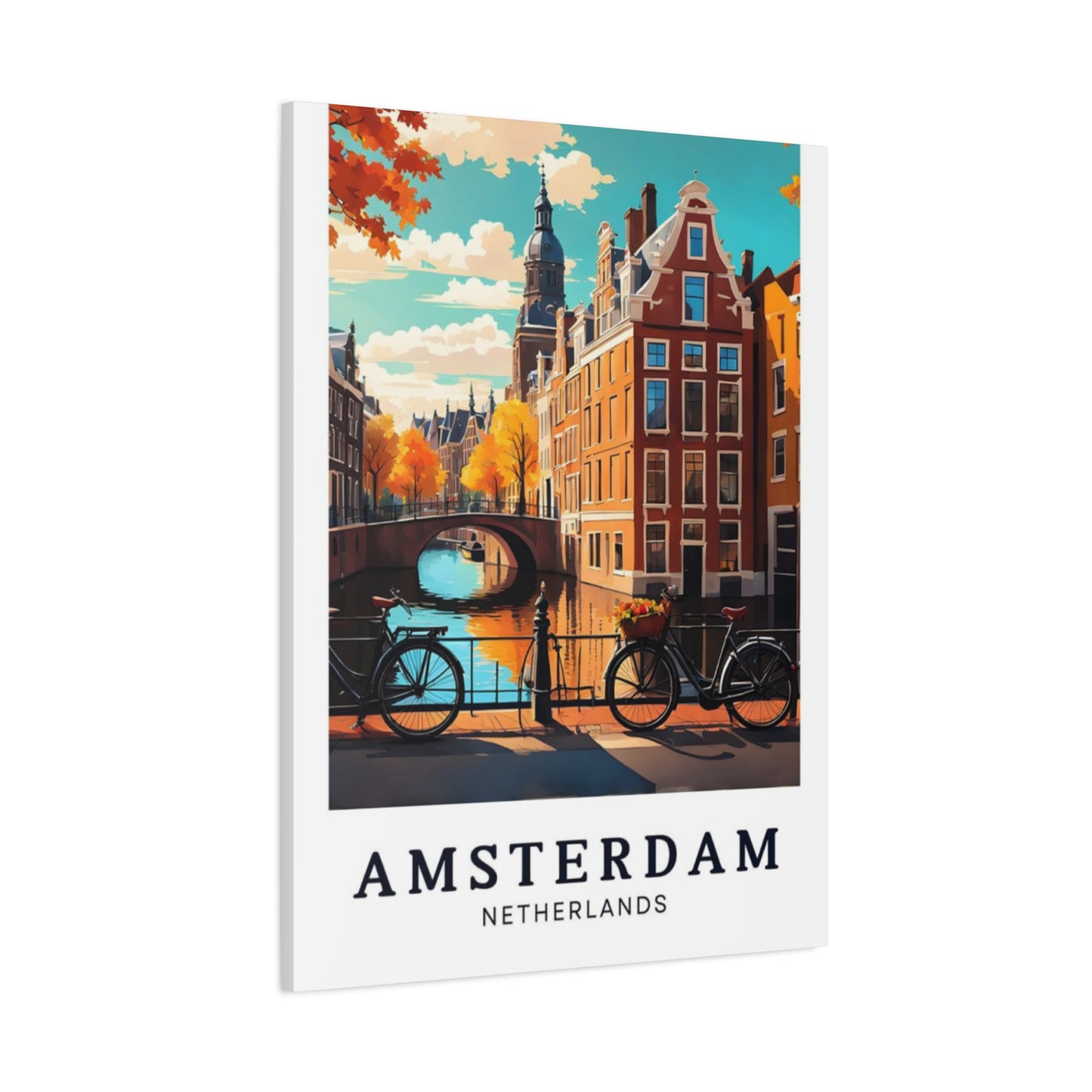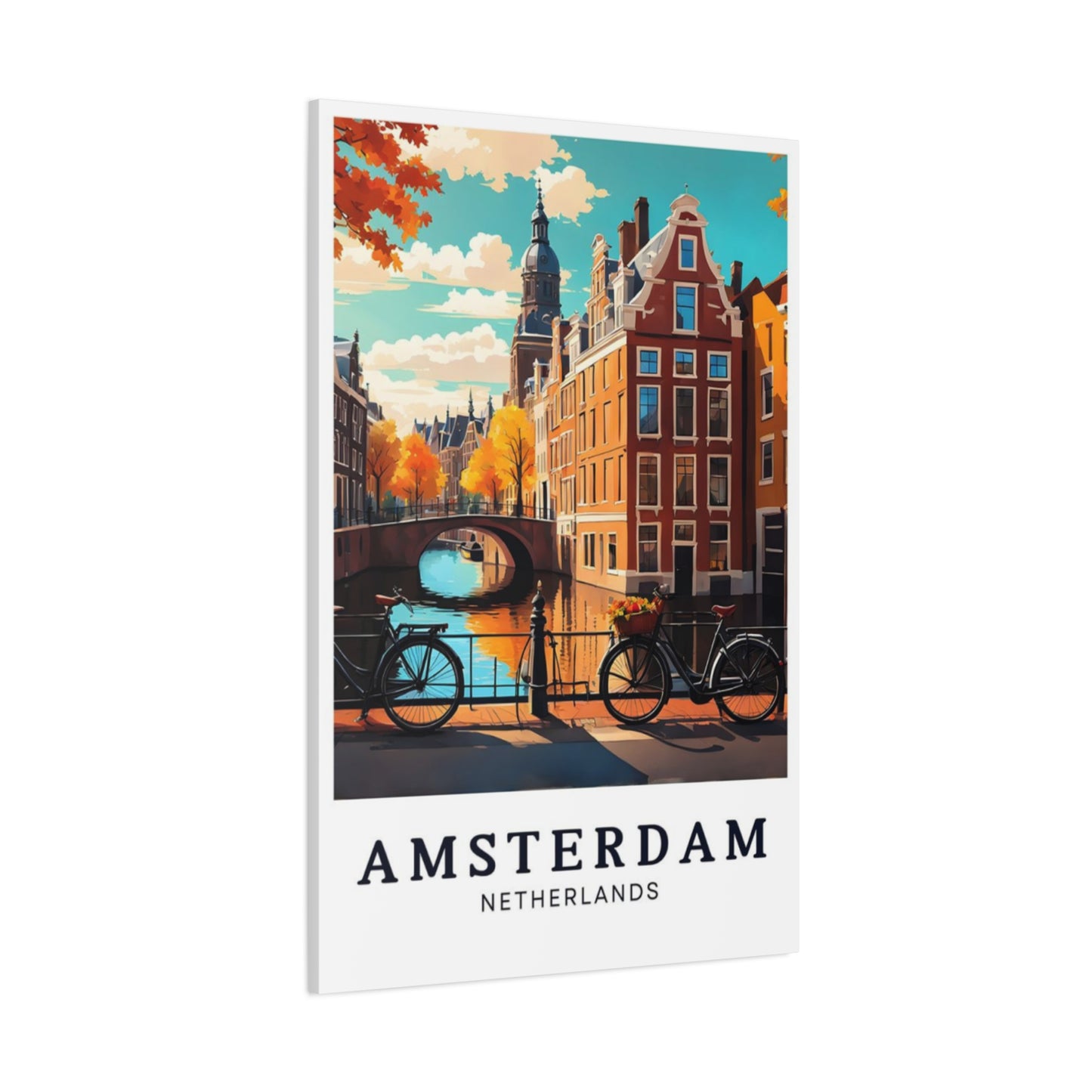Explore the Outdoors: Amsterdam National Park Canvas Wall Art
Amsterdam National Park stands as one of Europe's most remarkable natural treasures, offering visitors an extraordinary blend of pristine wilderness, diverse ecosystems, and countless outdoor adventures. Located in the heart of the Netherlands, this magnificent protected area spans thousands of hectares of untouched landscapes, providing sanctuary for countless species while offering endless opportunities for recreation and exploration.
The park's unique geography encompasses rolling hills, dense forests, meandering rivers, and expansive meadows that change dramatically with each season. From the vibrant spring blooms to the golden autumn foliage, Amsterdam National Park presents a constantly evolving canvas of natural beauty that captivates visitors throughout the year. The region's rich biodiversity supports an impressive array of wildlife, making it a premier destination for nature enthusiasts, photographers, and families seeking authentic outdoor experiences.
Established decades ago as a commitment to conservation and environmental protection, Amsterdam National Park has evolved into a model of sustainable tourism and ecological preservation. The park's management focuses on maintaining the delicate balance between providing public access and protecting the natural environment, ensuring that future generations can enjoy these pristine landscapes. Through careful planning and community involvement, the park continues to expand its conservation efforts while enhancing visitor experiences.
The park's strategic location makes it easily accessible from major urban centers, yet once inside its boundaries, visitors find themselves immersed in a world far removed from city life. Well-maintained infrastructure includes visitor centers, educational facilities, and an extensive network of trails that accommodate various skill levels and interests. Whether seeking solitude in remote wilderness areas or enjoying family-friendly activities near developed facilities, Amsterdam National Park offers something for every type of outdoor enthusiast.
Exploring Amsterdam National Park
Amsterdam National Park offers an incredible diversity of exploration opportunities that cater to adventurers of all ages and experience levels. The park's vast network of interconnected trails spans over 500 kilometers, winding through ancient forests, alongside pristine waterways, and across expansive meadows that showcase the region's natural splendor. Each trail has been carefully designed and maintained to provide visitors with safe, enjoyable access to the park's most spectacular landscapes while minimizing environmental impact.
The park's central visitor center serves as the perfect starting point for any exploration adventure. Here, knowledgeable staff provide detailed maps, current trail conditions, wildlife activity reports, and personalized recommendations based on individual interests and fitness levels. Interactive displays and educational exhibits help visitors understand the park's ecology, geology, and conservation efforts, enhancing their appreciation of the natural wonders they're about to encounter.
One of the park's most popular exploration routes begins at the main entrance and follows the Heritage Trail, a well-marked pathway that showcases the area's rich natural and cultural history. This moderate 8-kilometer loop takes approximately three hours to complete and features interpretive signs that explain the significance of various landmarks, geological formations, and ecosystems encountered along the way. The trail passes through old-growth forests where centuries-old trees create a cathedral-like canopy, crosses historic stone bridges, and offers spectacular viewpoints overlooking the park's most scenic valleys.
For those seeking more challenging exploration opportunities, the Wilderness Circuit provides a demanding 15-kilometer trek through the park's most remote and rugged terrain. This advanced route requires proper preparation, including sturdy hiking boots, weather-appropriate clothing, and sufficient water and food supplies. The trail rewards determined explorers with access to pristine alpine lakes, hidden waterfalls, and panoramic vistas that few visitors ever experience. Wildlife encounters are common along this route, with opportunities to observe deer, wild boar, and numerous bird species in their natural habitats.
The park's eastern section features a network of shorter exploration trails perfect for families and casual hikers. The Nature Discovery Loop, spanning just 3 kilometers, includes hands-on learning stations where children can examine tree bark textures, identify animal tracks, and observe insect life through provided magnifying glasses. This educational trail connects to several picnic areas and features accessible boardwalks that allow visitors of all mobility levels to enjoy the natural environment.
Seasonal exploration opportunities add another dimension to the Amsterdam National Park experience. Spring brings wildflower blooms that transform meadows into colorful carpets, while summer offers extended daylight hours perfect for longer expeditions. Autumn creates spectacular foliage displays that attract photographers from around the world, and winter transforms the landscape into a serene wonderland ideal for snowshoeing and cross-country skiing.
Top Trails in Amsterdam National Park Wall Art
The artistic inspiration found within Amsterdam National Park has created a unique culture of trail-based wall art that celebrates the natural beauty and cultural significance of the region's most beloved hiking routes. Local and visiting artists have collaborated with park management to create stunning murals, sculptures, and installations that enhance the outdoor experience while respecting the pristine environment. These artistic elements serve as waypoints, educational tools, and sources of inspiration for countless visitors who seek to capture and commemorate their park experiences.
The Riverside Art Trail represents one of the park's most ambitious artistic projects, featuring a series of large-scale murals painted on carefully selected rock formations along the park's primary waterway. Each mural tells a different story about the ecosystem, seasonal changes, wildlife behavior, or historical events that shaped the landscape. Local artists worked closely with ecologists and historians to ensure scientific accuracy while creating visually stunning works that blend seamlessly with the natural environment.
The mural depicting the annual migration of waterfowl spans nearly 30 meters of cliff face and uses perspective techniques that make the painted birds appear to fly directly out of the rock formation. Visitors often pause here for extended periods, mesmerized by the way changing light conditions throughout the day alter the artwork's appearance and emotional impact. The artist incorporated natural mineral pigments and weather-resistant techniques that allow the mural to age gracefully while maintaining its vibrant colors.
Another remarkable installation along the Forest Canopy Trail features a series of carved wooden sculptures that emerge organically from living trees. These works required years of planning and collaboration between artists and arborists to ensure no harm came to the forest ecosystem. The sculptures depict various woodland creatures in dynamic poses that change as visitors move along the trail, creating an animated story that unfolds over several kilometers of hiking.
The park's photography blind areas feature specially commissioned landscape paintings that help visitors understand what they might observe during different seasons and times of day. These educational art pieces show the same locations during various weather conditions, wildlife activity periods, and seasonal changes, helping photographers and nature observers optimize their viewing experiences. Professional nature artists created these works based on decades of field observations and scientific research.
Interactive art installations throughout the park encourage visitor participation while teaching environmental concepts. The Sound Garden features wind-powered sculptures that create musical tones when breezes move through the park's various microclimates. Visitors learn about air currents, weather patterns, and acoustic properties while enjoying a unique sensory experience that changes constantly with natural conditions.
The park's newest artistic addition involves augmented reality features accessible through a mobile application. Visitors can point their smartphones at specific trail markers to reveal digital art installations that overlay the natural environment with historical recreations, wildlife behavior demonstrations, or geological formation explanations. This innovative approach allows for dynamic, updatable content that enhances education without permanently altering the landscape.
Community involvement plays a crucial role in the park's artistic programs. Local schools regularly participate in temporary art projects that celebrate seasonal changes, environmental awareness themes, or cultural events. These student-created works are displayed in designated areas throughout the park, creating a rotating gallery that keeps the artistic landscape fresh and engaging for repeat visitors.
Amsterdam National Park for Families
Amsterdam National Park has earned recognition as one of Europe's premier family-friendly destinations, offering carefully designed programs and facilities that make outdoor adventures accessible and enjoyable for visitors of all ages. The park's commitment to family recreation extends beyond simple trail access to include educational programs, safety features, and amenities specifically designed to meet the needs of parents traveling with children of various ages and abilities.
The Family Adventure Center serves as the hub for all family-oriented activities within the park. This state-of-the-art facility features interactive exhibits, indoor and outdoor play areas, educational workshops, and specialized equipment rental services. Families can borrow child-sized hiking gear, safety equipment, nature exploration kits, and even specialized strollers designed for trail use. The center's staff includes certified naturalists and environmental educators who provide guidance on age-appropriate activities and safety considerations for family adventures.
The Junior Ranger Program represents one of the park's most popular family offerings, engaging children aged 6-12 in hands-on learning experiences that combine education with outdoor recreation. Participants receive official Junior Ranger badges, field journals, and specialized equipment as they complete various challenges throughout the park. Activities include wildlife tracking, plant identification, basic camping skills, and environmental stewardship projects. The program operates year-round with seasonal variations that highlight different aspects of park ecology and conservation.
Family camping facilities within Amsterdam National Park have been thoughtfully designed to accommodate groups of various sizes while maintaining connection to the natural environment. Family campsites feature level platforms for tents, nearby restroom facilities, potable water access, and designated fire rings for evening gatherings. Many sites include picnic tables, food storage lockers, and nearby playground equipment that allows children to burn energy safely while parents prepare meals or relax.
The park's trail system includes numerous family-friendly options that range from easy 1-kilometer nature walks to moderate 5-kilometer adventures suitable for older children and active families. The Butterfly Loop trail features elevated boardwalks that allow easy stroller access while providing excellent viewing opportunities for the park's abundant butterfly populations. Interpretive signs along this trail are positioned at child-friendly heights and include colorful illustrations that capture young visitors' attention.
Safety represents a primary concern for family visits, and Amsterdam National Park has implemented comprehensive measures to ensure secure outdoor experiences. All family trails feature regular emergency communication points, clear waypoint marking systems, and detailed safety information posted at regular intervals. Park rangers conduct regular patrols of family areas and provide emergency response capabilities 24 hours a day during peak season.
Educational programming designed specifically for families includes guided nature walks, campfire programs, astronomy sessions, and seasonal celebration events. The Evening Wildlife Program allows families to observe nocturnal animals in their natural habitats while learning about adaptation strategies and ecosystem relationships. Professional naturalists use specialized low-light equipment to safely observe creatures that remain hidden during daylight hours.
The park's water activities cater specifically to families with age-appropriate safety measures and equipment. Shallow swimming areas feature gradual entry points and constant supervision by certified lifeguards during designated hours. Canoe and kayak rentals include child-sized equipment and mandatory safety briefings that ensure all family members understand proper techniques and emergency procedures.
Wildlife Watching in Amsterdam's Parks Wall Art
The intersection of wildlife observation and artistic expression within Amsterdam National Park has created a unique cultural phenomenon that celebrates the region's incredible biodiversity through creative visual storytelling. Professional wildlife artists, nature photographers, and local artisans collaborate to create stunning wall art installations that educate visitors about the park's fauna while enhancing the aesthetic appeal of observation areas and visitor facilities.
The Wildlife Observation Gallery, located within the park's main visitor center, features rotating exhibitions of wildlife-themed artwork created by artists who spend extended periods observing and documenting animal behavior within the park boundaries. These works range from hyperrealistic paintings that capture minute details of feather patterns and fur textures to abstract interpretations that convey the emotional experience of wildlife encounters. Each piece includes detailed information about the species depicted, their ecological roles, and conservation status.
Strategically placed throughout the park's wildlife viewing blinds, educational murals provide visual guides that help visitors identify different species and understand their behavioral patterns. The Great Blue Heron mural, painted on the interior wall of the wetland observation shelter, shows the bird in various poses representing different activities such as fishing, preening, and nesting. Visitors can compare their live observations with the artistic representations, enhancing their understanding of avian behavior.
The park's photography hides feature carefully commissioned artwork that serves both educational and practical purposes. Large format prints showing the same locations during different seasons help wildlife photographers understand how lighting conditions, vegetation changes, and seasonal animal movements affect photographic opportunities. These reference images, created by renowned nature photographers, provide valuable insights that help visitors capture better images while minimizing disturbance to wildlife.
Interactive art installations throughout the park encourage deeper engagement with wildlife observation. The Bird Call Symphony installation features sculptural representations of various park birds alongside audio playback systems that reproduce their actual calls and songs. Visitors can learn to identify species by sound while appreciating the artistic interpretation of their physical characteristics. This multisensory approach significantly enhances wildlife identification skills.
The Mammal Tracking Wall, located along the Forest Loop Trail, presents life-sized artistic renderings of animal tracks, scat samples, and feeding signs commonly encountered within the park. Created in collaboration with experienced wildlife trackers and field biologists, these detailed representations help visitors recognize evidence of animal activity even when the creatures themselves remain hidden. The accompanying text explains seasonal variations in animal behavior and the ecological relationships between different species.
Seasonal art installations celebrate the changing wildlife activity patterns throughout the year. The Spring Migration Mural depicts dozens of bird species in scientifically accurate detail, showing their arrival timing, preferred habitats, and identifying characteristics. Created by a team of ornithologists and artists, this massive installation serves as both an identification guide and a celebration of one of nature's most spectacular annual events.
The park's newest artistic addition involves digital projection technology that creates dynamic wildlife displays on specially prepared surfaces during evening hours. These projections show footage of actual park wildlife combined with artistic elements that create immersive experiences for visitors. The technology allows for regular content updates that reflect current research findings and seasonal wildlife activity patterns.
Community involvement in wildlife art projects includes citizen science initiatives where visitors contribute wildlife photographs and observations that are incorporated into future artistic installations. This collaborative approach creates a sense of shared ownership while continuously expanding the park's documentation of biodiversity and ecological changes over time.
Scenic Spots in Amsterdam National Park
Amsterdam National Park encompasses dozens of breathtaking scenic locations that showcase the diverse beauty of Dutch natural landscapes, from sweeping vistas that stretch across multiple provinces to intimate forest clearings where sunlight filters through ancient canopies. These carefully preserved scenic areas represent the very best of the region's topographical diversity and provide countless opportunities for photography, contemplation, and outdoor recreation.
Eagle's Perch Overlook stands as the park's most famous scenic destination, perched atop the highest elevation within the park boundaries at 347 meters above sea level. The challenging 6-kilometer hike to reach this vantage point rewards visitors with panoramic views spanning over 50 kilometers in every direction during clear weather conditions. From this elevated position, visitors can observe the patchwork of agricultural lands, urban developments, and protected natural areas that characterize the Dutch landscape. The overlook features a stone platform with safety railings and interpretive signs that help visitors identify distant landmarks and understand the geological forces that shaped the region.
The Crystal Lake viewpoint offers one of the park's most photographed scenes, where pristine waters reflect the surrounding forest canopy in mirror-like perfection. This glacial lake, formed thousands of years ago during the last ice age, maintains remarkable clarity due to natural filtration through surrounding wetlands and minimal human disturbance. The designated viewing area includes comfortable benches positioned to optimize sunrise and sunset photography opportunities, while elevated boardwalks allow visitors to observe aquatic life without disturbing the delicate ecosystem.
Rainbow Falls represents the park's most dramatic water feature, where a 25-meter cascade creates spectacular mist displays that generate actual rainbows during optimal lighting conditions. The falls are most impressive during spring snowmelt and after significant rainfall events, when water volume reaches peak levels. Multiple viewing platforms accommodate visitors of different mobility levels, while the surrounding area features native wildflower gardens that bloom in succession throughout the growing season.
The Ancient Grove scenic area preserves some of the region's oldest trees, including several specimens estimated to be over 400 years old. These massive oaks, beeches, and pines create a cathedral-like atmosphere where filtered sunlight creates constantly changing patterns on the forest floor. The grove's central clearing features a circular stone arrangement used for educational programs and quiet contemplation, while surrounding trails allow visitors to experience these ancient giants from multiple perspectives.
Meadowlands Vista showcases the park's extensive grassland ecosystems, where seasonal wildflower displays create spectacular color variations throughout the year. This expansive area supports diverse wildlife populations and provides crucial habitat for ground-nesting birds, small mammals, and countless insect species. The scenic overlook includes telescopes available for public use during peak wildlife viewing periods, allowing visitors to observe animal behavior at distances that don't disturb natural activities.
The Sunset Promontory offers unobstructed western views that make it the park's premier location for evening photography and romantic occasions. This rocky outcrop extends beyond the treeline to provide 180-degree views across the valley, where changing light conditions create dramatic silhouettes and color variations during the golden hour. The area includes wind-sheltered seating areas and portable restroom facilities that accommodate extended visits during peak viewing times.
River Bend Scenic Drive follows the park's primary waterway for 12 kilometers, providing vehicle access to numerous scenic pullouts and overlooks. This paved route accommodates visitors with limited mobility while offering frequent opportunities to observe riparian ecosystems, water birds, and seasonal flood patterns. Each pullout features interpretive information about river ecology, flood management, and the historical importance of waterways in regional development.
Hiking Routes Around Amsterdam
The extensive network of hiking routes surrounding Amsterdam National Park offers outdoor enthusiasts access to some of Europe's most diverse and well-maintained trail systems, connecting the park's protected areas with regional recreation corridors and neighboring conservation sites. These carefully planned routes accommodate hikers of all skill levels while providing opportunities to experience the full spectrum of Dutch natural environments, from coastal dunes to inland forests.
The Trans-Regional Discovery Trail represents the area's most ambitious hiking project, spanning 85 kilometers and connecting five separate protected areas including Amsterdam National Park. This multi-day route can be completed in segments or as a continuous backpacking adventure, with strategically located camping areas and supply points every 15-20 kilometers. The trail passes through ancient forests, agricultural landscapes, historic villages, and restored wetland areas while following centuries-old migration routes used by both humans and wildlife.
Starting from the park's northern entrance, the Coastal Connection Route leads hikers on a 22-kilometer journey to the North Sea coastline, showcasing the dramatic transition from inland forests to maritime ecosystems. This moderate trail features relatively flat terrain with occasional sandy sections that require additional effort. Hikers experience diverse plant communities as they progress from temperate deciduous forests through transitional heath lands to coastal dune systems. The route includes several historic landmarks and provides excellent bird watching opportunities during migration seasons.
The Forest Circuit Loop offers a more manageable 12-kilometer option that remains entirely within the park boundaries while visiting most major scenic destinations. This well-marked trail features moderate elevation changes and takes approximately 4-5 hours to complete at a comfortable pace. The route passes through old-growth forest sections, crosses multiple streams via rustic bridges, and provides access to several waterfalls and scenic overlooks. Rest areas positioned every 3 kilometers include basic amenities and emergency communication devices.
Advanced hikers seeking challenging terrain should consider the Ridge Walker's Route, a demanding 18-kilometer trail that follows the park's highest elevations and most rugged topography. This expert-level route requires proper equipment, physical fitness, and experience with challenging trail conditions. Rewards include exclusive access to remote scenic areas, excellent wildlife observation opportunities, and a genuine wilderness experience rare in densely populated regions. The trail features significant elevation changes, rocky sections, and creek crossings that may require waterproof footwear.
The Heritage Villages Loop combines hiking with cultural exploration, leading visitors on a 16-kilometer journey through several historic settlements that predate the park's establishment. This moderate trail provides insights into traditional Dutch rural life while showcasing how human activities have shaped the landscape over centuries. Hikers pass restored farmhouses, traditional mills, and historic churches while following ancient pathways that connected these communities for generations.
Family-friendly hiking options include the Woodland Adventure Trail, designed specifically for children and beginning hikers. This 5-kilometer route features interactive stations, educational displays, and playground equipment positioned at regular intervals. The trail maintains gentle grades and wide pathways suitable for strollers while providing access to streams, wildlife viewing areas, and picnic facilities. Seasonal scavenger hunt programs add educational value and entertainment for young visitors.
The Photographer's Circuit caters to serious photography enthusiasts with a carefully planned 14-kilometer route that visits optimal viewing locations during the best lighting conditions. This specialized trail includes detailed timing suggestions, seasonal recommendations, and technical information about camera settings for different locations. The route connects major scenic destinations while avoiding crowds during peak photography hours, allowing dedicated artists to capture exceptional images of the park's natural beauty.
Amsterdam National Park Photography Tips
Amsterdam National Park offers exceptional photography opportunities throughout the year, with diverse landscapes, abundant wildlife, and changing seasonal conditions creating endless possibilities for capturing stunning images. Successful photography in this environment requires understanding of both technical considerations and environmental factors that influence lighting, wildlife behavior, and access to optimal shooting locations.
Equipment selection plays a crucial role in park photography success. A versatile zoom lens in the 24-70mm range provides excellent coverage for landscape shots, while a 70-200mm telephoto lens enables wildlife photography without disturbing animal behavior. Wide-angle lenses between 14-24mm capture expansive vistas and forest interiors effectively. Macro lenses reveal intricate details of flowers, insects, and forest floor compositions that often go unnoticed by casual observers. Weather protection for cameras becomes essential during the park's frequent precipitation, while sturdy tripods ensure sharp images during low-light conditions common in forest environments.
Golden hour photography in Amsterdam National Park produces the most dramatic landscape images, with optimal lighting occurring during the first hour after sunrise and the last hour before sunset. The park's eastern overlooks provide excellent sunrise opportunities, while western-facing locations capture spectacular sunset conditions. Spring and autumn offer particularly favorable lighting conditions due to the sun's lower angle and more colorful atmospheric conditions created by seasonal weather patterns.
Wildlife photography requires patience, preparation, and respect for animal welfare. Early morning and late evening periods provide the best opportunities for observing active wildlife, as many species avoid midday heat and human activity. The park's wildlife viewing blinds offer concealment and optimal positioning for bird and mammal photography, while requiring advance reservations during peak seasons. Telephoto lenses minimize disturbance while capturing detailed behavioral images, though photographers must remain prepared for sudden movement and changing lighting conditions.
Seasonal photography considerations dramatically affect image opportunities and technical requirements. Spring wildflower displays create colorful foreground elements for landscape compositions, while autumn foliage provides warm color palettes and dramatic contrasts. Winter snow conditions transform familiar locations into completely different photographic opportunities, though cold weather impacts battery life and requires special handling precautions for electronic equipment.
Composition techniques specific to park environments include using leading lines created by trails, streams, and tree lines to guide viewer attention through images. Layering different elements at various distances creates depth and visual interest in forest photography, while incorporating foreground elements adds scale and context to sweeping landscape views. The rule of thirds applies particularly well to scenic overlook photography, where horizon placement and focal point positioning significantly impact image balance and emotional impact.
Weather considerations extend beyond simple precipitation to include fog, wind, and atmospheric conditions that create unique photographic opportunities. Morning fog often generates mysterious, ethereal effects in forest environments, while post-storm lighting produces exceptional contrast and clarity. Wind patterns affect both camera stability and wildlife behavior, requiring photographers to adapt techniques and expectations accordingly.
Technical settings for park photography vary significantly based on lighting conditions and subject matter. Forest interior shooting often requires higher ISO settings and wider apertures to compensate for reduced light levels, while bright daylight conditions may necessitate neutral density filters to achieve desired exposure effects. Understanding your camera's dynamic range limitations helps in challenging lighting situations common when transitioning between forest shade and bright clearings.
Post-processing considerations for park photography should enhance rather than dramatically alter natural colors and lighting conditions. Subtle adjustments to contrast, saturation, and sharpness can improve image impact while maintaining realistic representation of the natural environment. HDR techniques prove useful for high-contrast situations but should be applied judiciously to avoid unnatural appearance.
Seasonal Activities in the Park
Amsterdam National Park transforms dramatically throughout the year, offering distinctly different recreational opportunities and natural experiences during each season. Understanding these seasonal variations helps visitors plan optimal timing for specific activities while appreciating the park's year-round beauty and ecological diversity. The park's management has developed specialized programs and facilities that take advantage of each season's unique characteristics.
Spring arrives in Amsterdam National Park typically in late March, bringing explosive wildflower blooms that attract photographers and nature lovers from across Europe. The Spring Wildflower Festival, held annually during peak bloom period, features guided botanical walks, photography workshops, and educational programs about pollinator relationships. During this season, hiking conditions improve significantly as winter ice and snow disappear, though trail conditions can remain muddy in low-lying areas. Bird migration reaches peak activity levels, making spring an exceptional time for birdwatching and wildlife observation.
The park's spring activities include specialized programs for families with children, such as the Easter Egg Hunt that combines traditional celebration with environmental education. Children search for biodegradable eggs hidden throughout designated trail areas while learning about local wildlife reproduction patterns and seasonal behavior changes. Spring camping becomes increasingly popular as temperatures moderate and daylight hours extend, though visitors should prepare for variable weather conditions and occasional late-season frost.
Summer transforms Amsterdam National Park into a bustling hub of outdoor recreation, with extended daylight hours allowing for ambitious hiking expeditions and multi-day camping adventures. Water activities reach peak season as lakes and streams warm to comfortable temperatures for swimming, kayaking, and fishing. The Summer Solstice Celebration features overnight programs where visitors experience the park's longest day through guided nocturnal activities, astronomy sessions, and dawn wildlife observation programs.
During summer months, the park implements special management protocols to handle increased visitor volumes while protecting sensitive ecosystems. Advanced reservation systems ensure camping and popular trail access remain manageable, while additional ranger staff provide enhanced safety monitoring and visitor assistance. Summer photography opportunities focus on lush vegetation, active wildlife, and extended golden hour periods that create exceptional lighting conditions.
Autumn represents many visitors' favorite season in Amsterdam National Park, when deciduous forests explode in vibrant colors ranging from golden yellows to deep burgundy reds. The Fall Foliage Festival celebrates this spectacular display with specialized tours, photography contests, and educational programs about forest ecology and seasonal changes. Cooler temperatures create ideal hiking conditions while reduced insect activity makes outdoor recreation more comfortable.
Wildlife activity intensifies during autumn as animals prepare for winter months through increased feeding behavior and territorial activities. This seasonal change creates exceptional observation opportunities for visitors interested in animal behavior, though it also requires greater awareness and safety precautions when encountering potentially territorial species. Autumn camping offers comfortable temperatures and spectacular scenery, though shorter daylight hours require careful trip planning.
Winter activities in Amsterdam National Park cater to visitors seeking peaceful, contemplative outdoor experiences in a transformed landscape. Snow-covered trails become accessible for cross-country skiing and snowshoeing, with equipment rental available at the visitor center. The Winter Solstice Program offers unique opportunities to experience the park's shortest day through guided activities that celebrate the season's beauty and ecological significance.
Cold weather wildlife observation reveals species and behaviors rarely seen during other seasons, as animals adapt survival strategies to harsh conditions. Winter photography presents challenging but rewarding opportunities, with snow-covered landscapes creating dramatic contrasts and simplified compositions. The park maintains heated shelters and warming stations along major trails to ensure visitor safety during extreme weather conditions.
Biking Adventures in Amsterdam National Park
Amsterdam National Park has developed one of Europe's most comprehensive mountain biking and cycling networks, featuring over 200 kilometers of purpose-built trails that accommodate riders from beginners to advanced athletes. These carefully designed routes take advantage of the park's diverse topography while minimizing environmental impact through sustainable trail construction techniques and strategic routing that avoids sensitive ecological areas.
The park's cycling infrastructure includes three distinct trail systems designed for different skill levels and riding preferences. The Family Cycling Network consists of paved and packed gravel paths suitable for road bikes, hybrid bicycles, and families with children. These routes follow gentler gradients and provide frequent rest areas, scenic overlooks, and educational stops that make cycling accessible to visitors of all ages and fitness levels. The network connects major park facilities and camping areas while offering safe, enjoyable cycling experiences.
Intermediate riders gravitate toward the Cross-Country Trail System, featuring 75 kilometers of single-track and doubletrack trails with moderate technical challenges and elevation changes. These routes wind through dense forests, cross streams via purpose-built bridges, and climb to scenic overlooks that provide spectacular views as rewards for physical effort. Trail conditions vary seasonally, with spring and autumn offering optimal traction and temperature conditions for extended rides.
Advanced mountain bikers can challenge themselves on the Expert Trail Network, featuring technical single-track sections with significant elevation changes, rock gardens, root sections, and other natural obstacles that demand high skill levels and specialized equipment. These trails access the park's most remote and pristine areas while providing authentic wilderness cycling experiences rare in densely populated regions. Safety equipment requirements include helmets, protective gear, and emergency communication devices for these challenging routes.
Electric bicycle options have revolutionized park cycling by making challenging terrain accessible to riders with limited fitness levels or physical limitations. The park's rental facility offers high-quality e-bikes with extended battery life and specialized components designed for trail use. Charging stations positioned throughout the park ensure that even extended rides remain feasible for electric bicycle users, while guided e-bike tours provide structured experiences for visitors unfamiliar with electric bicycle operation.
Seasonal cycling considerations significantly impact trail selection and safety requirements. Spring conditions can include muddy sections and occasional trail closures due to maintenance activities, while summer offers optimal weather and trail conditions at the cost of increased trail traffic. Autumn provides spectacular scenery and comfortable temperatures, though fallen leaves can create slippery conditions on technical sections. Winter cycling becomes possible on designated trails that receive regular maintenance and snow clearing.
Bike maintenance and repair services operate from the main visitor center, offering everything from basic tire repairs to complete overhauls for visitors experiencing mechanical difficulties during their park adventures. The facility stocks common replacement parts and provides tool lending for riders preferring to perform their own maintenance. Professional mechanics offer advice on equipment selection and trail preparation for visitors planning extended cycling adventures.
Guided cycling tours cater to various interests and skill levels, from leisurely nature rides that focus on wildlife observation and botanical education to challenging mountain biking expeditions that tackle the park's most demanding terrain. Professional guides provide safety instruction, mechanical support, and detailed knowledge about park ecology and history that enhances the overall cycling experience. Photography tours combine cycling with instruction in outdoor photography techniques and provide access to optimal shooting locations throughout the park.
The park's cycling community includes regular organized events such as endurance challenges, skills clinics, and maintenance workshops that bring together riders with shared interests in outdoor recreation and environmental stewardship. These events foster connections between visitors and local cycling enthusiasts while promoting responsible trail use and conservation awareness.
Hidden Gems of Amsterdam National Park
Beyond the well-known attractions and popular destinations, Amsterdam National Park harbors numerous secluded locations and lesser-known features that provide exceptional experiences for visitors willing to venture beyond marked trails and crowded areas. These hidden gems represent some of the park's most pristine and undisturbed environments, offering opportunities for solitude, unique wildlife encounters, and discovery of natural wonders that few visitors ever experience.
The Whispering Cave system, accessible only through a unmarked trail beginning near the eastern boundary, contains a network of limestone chambers created by underground water flow over thousands of years. These natural formations create acoustic phenomena where whispered sounds carry remarkably long distances through the chambers, while complete silence amplifies the subtle sounds of dripping water and air movement. The caves maintain constant temperatures year-round and provide habitat for several rare bat species that roost in the deeper chambers.
Hidden Spring Valley represents one of the park's most botanically diverse areas, sheltered between two ridges and fed by natural springs that maintain moisture levels supporting rare plant species found nowhere else in the region. Access requires a challenging 3-kilometer hike through unmarked terrain, but the destination rewards visitors with pristine wetland environments, unique wildflower displays, and exceptional bird watching opportunities. The valley's microclimate supports several endangered plant species that researchers study as indicators of regional environmental health.
The Ancient Stone Circle, predating the park's establishment by several centuries, consists of carefully arranged granite boulders that mark an indigenous ceremonial site of historical significance. Located in a remote forest clearing accessible only to hikers willing to navigate unmarked trails, this archaeological feature provides insight into the region's pre-European cultural history. Park management maintains the site's integrity while allowing respectful visitation by individuals and small groups.
Moonlight Falls emerges from an underground stream system to create a delicate 8-meter cascade that remains largely unknown due to its remote location and difficult access route. The waterfall achieves peak flow during spring snowmelt and after significant rainfall events, while during dry periods it may reduce to a mere trickle. The surrounding area features moss-covered rocks and fern grottos that create a fairytale-like atmosphere enhanced by filtered sunlight and pristine acoustics.
The Secret Garden meadow, hidden within dense forest boundaries, opens suddenly to reveal a natural clearing filled with rare wildflowers and maintained by occasional deer browsing activity. This location provides exceptional photography opportunities during peak bloom periods, while its isolation ensures minimal human disturbance to the delicate ecosystem. The meadow's seasonal changes create different visual experiences throughout the year, from spring wildflower displays to autumn grass seed formations.
Eagle's Hollow represents a geological depression created by ancient glacial activity, now supporting a unique ecosystem that combines elements of wetland and forest environments. The hollow's protected microclimate allows sensitive species to thrive while providing nesting habitat for several rare bird species. Access requires careful navigation through unmarked trails, but the destination offers exceptional wildlife observation opportunities for patient visitors.
The Hermit's Retreat consists of natural rock formations that create sheltered camping areas once used by individuals seeking solitude and spiritual connection with nature. These formations provide wind protection and water access while maintaining complete privacy from other park areas. Modern visitors can experience primitive camping in these locations with proper permits and adherence to Leave No Trace principles.
Crystal Pool, fed by underground springs, maintains remarkable clarity and constant temperature throughout the year. This small but deep pool supports unique aquatic life adapted to its specific conditions while providing a peaceful location for contemplation and nature observation. The pool's remote location requires significant hiking effort to reach, ensuring that only dedicated visitors discover this pristine aquatic environment.
Picnic Spots in Amsterdam Parks
Amsterdam National Park provides numerous exceptional picnic locations that combine natural beauty with practical amenities, creating perfect settings for family gatherings, romantic meals, and group celebrations in pristine outdoor environments. These carefully selected and maintained picnic areas offer diverse settings from lakeside pavilions to forest clearings, each providing unique advantages for different types of outdoor dining experiences.
Lakeside Pavilion represents the park's premier group picnic destination, featuring a covered shelter that accommodates up to 50 people while providing unobstructed views across the park's largest lake. This facility includes multiple picnic tables, fire pits for cooking, potable water access, and nearby restroom facilities that make it ideal for extended family reunions and organizational events. The pavilion's elevated position provides protection from ground moisture while offering spectacular sunrise and sunset views that enhance dining experiences.
Conclusion
Amsterdam National Park canvas wall art offers a captivating way to bring the beauty, serenity, and diversity of nature into your home. By featuring scenic landscapes, vibrant greenery, and intricate depictions of wildlife, these artworks transform walls into immersive focal points that celebrate the outdoors and inspire a deeper connection with the natural world. Whether displayed in living rooms, bedrooms, offices, or creative spaces, National Park-themed canvas art elevates interiors by combining aesthetic sophistication with the calming influence of nature, creating spaces that are both visually appealing and emotionally restorative.
The appeal of Amsterdam National Park wall art lies in its ability to capture the essence of natural landscapes through thoughtful composition, color, and texture. Artists often depict lush forests, meandering rivers, and native wildlife in ways that highlight light, shadow, and seasonal nuances. The interplay of greens, blues, and earth tones creates a sense of depth and tranquility, drawing viewers into the scene and evoking the peaceful rhythm of the outdoors. Each piece not only decorates walls but also tells a story, transporting observers to the park’s serene trails, open meadows, and scenic vistas.
Beyond aesthetic value, Amsterdam National Park canvas art carries symbolic and emotional significance. Nature represents balance, growth, and renewal, offering an opportunity to create reflective and mindful spaces within the home. Incorporating these artworks encourages relaxation, fosters creativity, and promotes a sense of well-being. Each canvas becomes more than decoration; it is a reminder of the importance of preserving natural beauty and cultivating a connection with the environment, inspiring viewers to appreciate both the simplicity and grandeur of the outdoors.
From a design perspective, National Park wall art is versatile and adaptable. Large-scale canvases serve as dramatic statement pieces in living rooms, offices, or recreational spaces, while smaller prints or curated series enhance hallways, bedrooms, or study areas. The natural color palettes harmonize with contemporary, rustic, or eclectic interiors, providing cohesion and warmth. Thoughtful placement ensures that each piece captures attention while complementing the overall décor.
Ultimately, Amsterdam National Park canvas wall art is more than decoration—it is an invitation to bring the tranquility, beauty, and majesty of nature indoors. By thoughtfully integrating these pieces into your home, you can create immersive, restorative spaces that inspire reflection, elevate interior design, and celebrate the enduring charm of the outdoors. Each artwork transforms walls into scenic escapes, offering a visual and emotional connection to the serene landscapes of Amsterdam National Park.



































